How Long Does a 9v Battery Last? (Battery Life & Tips)
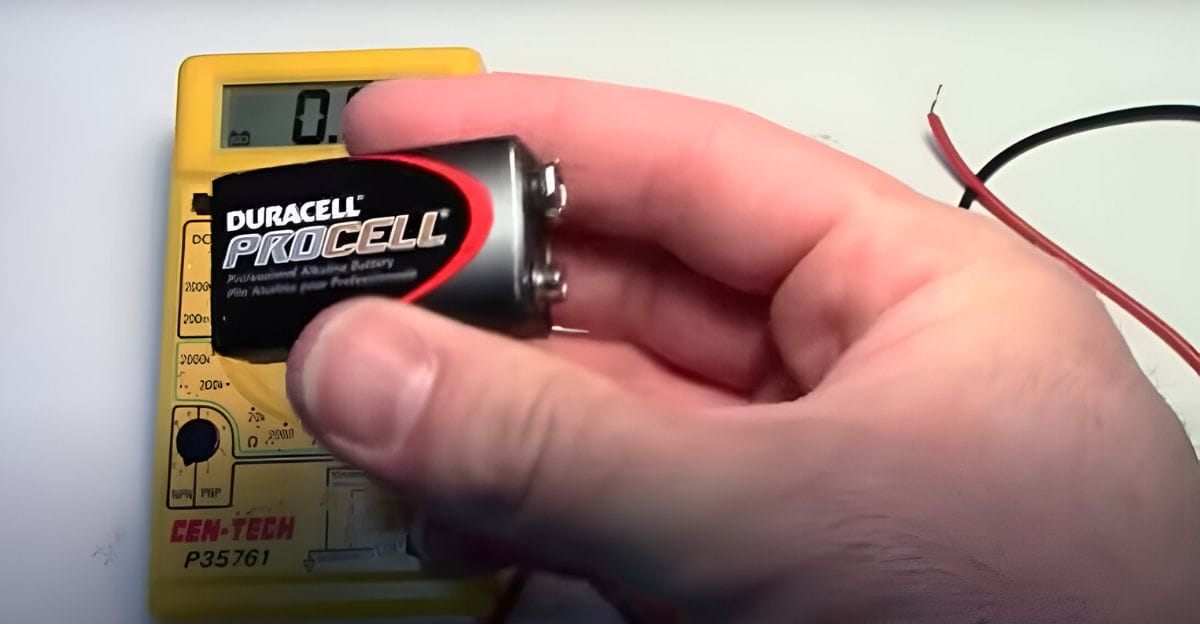
The 9v battery is a commonly used, general-purpose, rectangular battery with snap connectors at its top.
It’s a standard form factor manufactured by many companies and available in different chemistries, capacities, types, qualities, etc.
How long a 9v battery lasts depends primarily on what type of battery it is, its capacity, and its current consumption. For example, a 9V NiMH battery may last up to 4 hours, whereas a 9v Li-ion battery may last over 8 hours. The continuous runtime of a sample of 9-volt batteries ranged between 1.2 hours (NiCd) and 12 hours (Lithium) for a 100 mAh load. If not used continuously, they can generally last up to a few months or even a few years, depending on their quality and other factors.
The general formula to calculate battery life:
Battery Life = Battery Capacity / Load CurrentI will also show you how to calculate the expected lifetime if you know the battery’s capacity and the device’s current consumption.
How Long Do 9V Batteries Last
The 9v battery only defines the form factor.
Although the nominal voltage is 9 volts, the actual voltage can range between 7.2 and 9.6 volts. How long 9v batteries last depends on the chemistry used to make them, the manufacturer, their quality, and how frequently and heavily you use them, among other factors.
Chemistry
Standard (PP3), non-rechargeable 9v batteries are typically made from alkaline, carbon zinc, and lithium.
Nickel-cadmium (NiCd), nickel-metal hydride (NiMH), and some lithium-ion batteries are designed to be rechargeable.
Generally, lithium-based (including lithium compounds) 9v batteries last longer than 9v batteries with non-lithium-based chemistries.
Capacity
The higher the capacity of the 9v battery, the longer you can expect it to last.
See below, under ’Calculating the Expected Lifetime’.
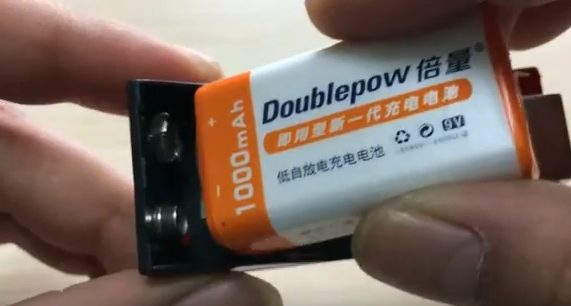
Usage
Usage is important because, as you would expect, the more continuously and heavily you use the battery, the quicker it drains.
For example, a smoke detector might only need to use battery power a little at a time, as a TV remote, but a child playing with a remote-controlled car would want to extract as much electrical “juice” as they want within a short period.
A flashlight and digital camera would normally also consume power quickly unless you use them occasionally and for a short time.
So, if used infrequently in a low-powered device, it can last several months or even a few years, but if used frequently in a high-powered one, it will only last a few hours.
Quality
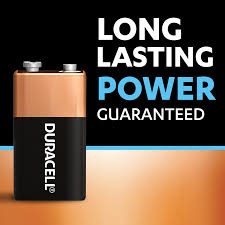
Duracell is a brand known for producing high-quality batteries.
They generally last longer than batteries produced by other companies. They can retain their charge for up to 5 years if left unused. Other high-quality 9v batteries may have a similar capability.
Expensive versions of high-quality batteries are specially designed to have a long storage life. For example, the Ultralife lithium 9v battery is said to have a shelf-life of up to 10 years.
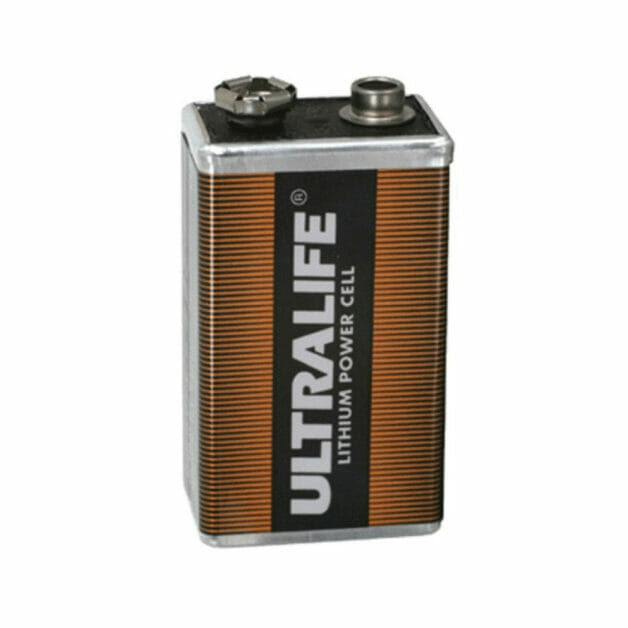
Size
Most 9-volt batteries have dimensions of 17.5 mm x 26.5 mm x 48.5 mm.
This standard size is identified as PP3. However, other sizes also exist, with higher capacities, so size also makes a difference.
At present, only PP6 (1 Ah), PP7 (2.5 Ah), and PP9 (5 Ah) 9-volt batteries are still produced, compared with the typical capacity of 550 mAh of an alkaline-based PP3 9v battery. Their higher capacities mean you can expect them to last longer.
So, a PP6 9v battery may last almost twice as long as a typical PP3 9v battery, and so on.
Calculating the Expected Lifetime
You can calculate the expected lifetime if you know the battery’s capacity (in mAh or Ah).
One mAh is one-thousandth of an ampere-hour (Ah). A 1 Ah-rated battery can provide 1 amp of current for 1 hour before it needs to be recharged or disposed of.
For example, a typical 9v alkaline battery has a capacity rating of 550mAh. Divide this by the current consumption to get the estimated time it will last. Supposing it’s 100mA, we get this:
550 mAh / 100 mA = 5.5 hours
So, a 9v 550mAh alkaline battery will last about 5.5 hours if used continuously.
The general formula for calculating battery life is:
Battery Life = Battery Capacity / Load CurrentLithium batteries have greater capacity (around 320-1,200 mAh), so they will typically last longer. Theoretically, they should give up to about 40 hours of continuous use, depending on how heavily you use it, but in practice, it would be a little less due to inefficiencies.
Typical Runtimes
The table shows the typical runtimes of a range of 9v batteries with different chemistries, assuming the device they are connected to operates on 100 mAh.
If the current consumption is less than 100 mAh, it will last longer than stated here, and if it is higher, the runtime will be shorter.
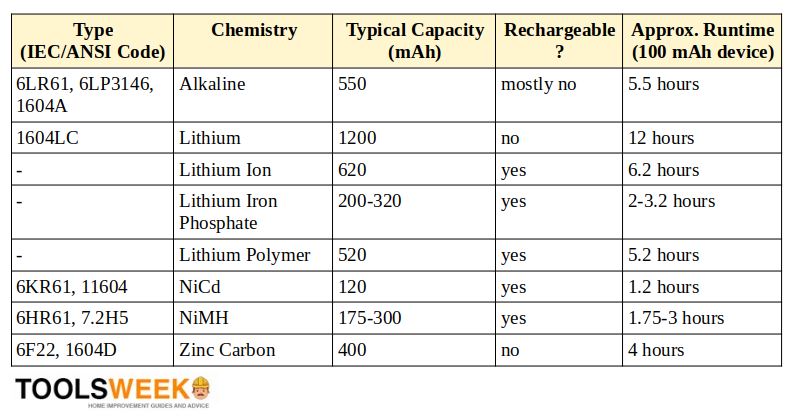
So, as you can see, the current consumption can make a huge difference. Whereas a 100 mAh device may last about 5.5 hours on an alkaline 9v battery, using the same battery to supply a ten mAh device would increase the runtime by tenfold. It will theoretically last 55 hours. Considering inefficiencies, you can expect it to run for at least 50 hours or more than two full days, even if used continuously.
Refer to our handy table and chart below to estimate the runtime for different loads between 20 and 220 mAh.

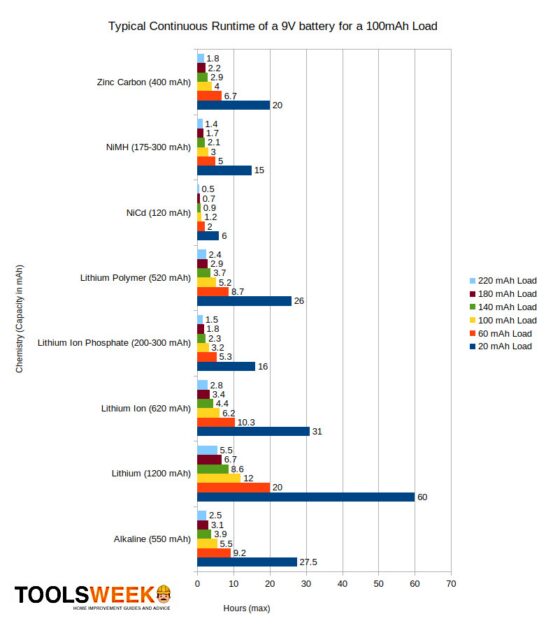
Replacing a 9V Battery
Replacing a 9V battery is necessary when it can no longer provide an adequate charge to operate the device.
It depends on how much power the device requires to operate normally. Still, generally, you can expect the 9v battery to be no longer useful if its voltage level drops below 5.4 volts. If the battery is visibly damaged or its terminals are corroded, you should replace it immediately.
You can use a voltmeter, multimeter, or a specially designed battery test to test its voltage.
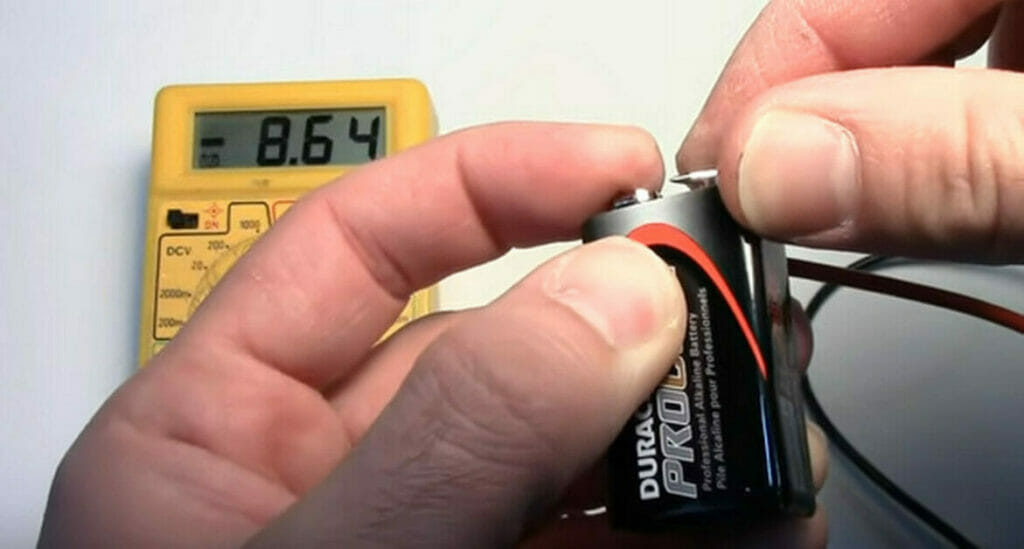
How 9-Volt Batteries Compare
Compared to typical AA and AAA batteries, which are cylindrical, 9v batteries generally have a lower capacity.
This means they usually don’t last as long as AA and AAA batteries. This, along with the low-power requirements of newer devices, might explain the declining popularity of PP3 9v batteries.
For example, whereas an alkaline-based PP3 9v battery has a typical capacity of 550 mAh, an AA battery of the same chemistry has a 1800-2700 mAh capacity.
But AA and AAA batteries have less voltage (1.5V), so you would need 6 to provide the same voltage as a single 9v battery, which would also take up less space in the device.
References
Website Resources:
- 9V Ultralife Battery. https://cdn11.bigcommerce.com/s-zgr9xks/images/stencil/1280×1280/products/366/830/9v_battery__00825__45839.1566415604.png?c=2
- Duracell Ultra Alkaline 9V Battery. https://www.duracell.in/product/ultra-alkaline-9v-batteries/
Video References:
AdamDIY
Intelliplus quarters
